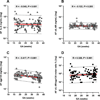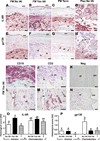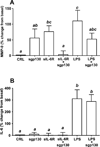IL-6 trans-signaling system in intra-amniotic inflammation, preterm birth, and preterm premature rupture of the membranes
- PMID: 21282511
- PMCID: PMC3800180
- DOI: 10.4049/jimmunol.1003587
IL-6 trans-signaling system in intra-amniotic inflammation, preterm birth, and preterm premature rupture of the membranes
Abstract
Classic IL-6 signaling is conditioned by the transmembrane receptor (IL-6R) and homodimerization of gp130. During trans-signaling, IL-6 binds to soluble IL-6R (sIL-6R), enabling activation of cells expressing solely gp130. Soluble gp130 (sgp130) selectively inhibits IL-6 trans-signaling. To characterize amniotic fluid (AF) IL-6 trans-signaling molecules (IL-6, sIL-6R, sgp130) in normal gestations and pregnancies complicated by intra-amniotic inflammation (IAI), we studied 301 women during second trimester (n = 39), third trimester (n = 40), and preterm labor with intact (n = 131, 85 negative IAI and 46 positive IAI) or preterm premature rupture of membranes (PPROM; n = 91, 61 negative IAI and 30 positive IAI). ELISA, Western blotting, and real-time RT-PCR were used to investigate AF, placenta, and amniochorion for protein and mRNA expression of sIL-6R, sgp130, IL-6R, and gp130. Tissues were immunostained for IL-6R, gp130, CD15(+) (polymorphonuclear), and CD3(+) (T cell) inflammatory cells. The ability of sIL-6R and sgp130 to modulate basal and LPS-stimulated release of amniochorion matrix metalloprotease-9 was tested ex vivo. We showed that in physiologic gestations, AF sgp130 decreases toward term. AF IL-6 and sIL-6R were increased in IAI, whereas sgp130 was decreased in PPROM. Our results suggested that fetal membranes are the probable source of AF sIL-6R and sgp130. Immunohistochemistry and RT-PCR revealed increased IL-6R and decreased gp130 expression in amniochorion of women with IAI. Ex vivo, sIL-6R and LPS augmented amniochorion matrix metalloprotease-9 release, whereas sgp130 opposed this effect. We conclude that IL-6 trans-signaling molecules are physiologic constituents of the AF regulated by gestational age and inflammation. PPROM likely involves functional loss of sgp130.
Figures






Similar articles
-
The balance of interleukin (IL)-6, IL-6·soluble IL-6 receptor (sIL-6R), and IL-6·sIL-6R·sgp130 complexes allows simultaneous classic and trans-signaling.J Biol Chem. 2018 May 4;293(18):6762-6775. doi: 10.1074/jbc.RA117.001163. Epub 2018 Mar 20. J Biol Chem. 2018. PMID: 29559558 Free PMC article.
-
Amniotic fluid fetal hemoglobin in normal pregnancies and pregnancies complicated with preterm labor or prelabor rupture of membranes.J Matern Fetal Neonatal Med. 2009 May;22(5):388-97. doi: 10.1080/14767050802578285. J Matern Fetal Neonatal Med. 2009. PMID: 19529995 Free PMC article.
-
Maternal Plasma and Amniotic Fluid LBP, Pentraxin 3, Resistin, and IGFBP-3: Biomarkers of Microbial Invasion of Amniotic Cavity and/or Intra-amniotic Inflammation in Women with Preterm Premature Rupture of Membranes.J Korean Med Sci. 2021 Nov 15;36(44):e279. doi: 10.3346/jkms.2021.36.e279. J Korean Med Sci. 2021. PMID: 34783213 Free PMC article.
-
Interleukin-6 and its receptors: a highly regulated and dynamic system.Cytokine. 2014 Nov;70(1):11-20. doi: 10.1016/j.cyto.2014.05.024. Epub 2014 Jun 28. Cytokine. 2014. PMID: 24986424 Review.
-
IL-6 trans-signaling via the soluble IL-6 receptor: importance for the pro-inflammatory activities of IL-6.Int J Biol Sci. 2012;8(9):1237-47. doi: 10.7150/ijbs.4989. Epub 2012 Oct 24. Int J Biol Sci. 2012. PMID: 23136552 Free PMC article. Review.
Cited by
-
Sex differences in the relationship of IL-6 signaling to cancer cachexia progression.Biochim Biophys Acta. 2015 May;1852(5):816-25. doi: 10.1016/j.bbadis.2014.12.015. Epub 2014 Dec 30. Biochim Biophys Acta. 2015. PMID: 25555992 Free PMC article.
-
Recent Advances and Challenges in the Early Diagnosis and Treatment of Preterm Labor.Bioengineering (Basel). 2024 Feb 6;11(2):161. doi: 10.3390/bioengineering11020161. Bioengineering (Basel). 2024. PMID: 38391647 Free PMC article. Review.
-
Systematic review of preterm birth multi-omic biomarker studies.Expert Rev Mol Med. 2022 Apr 5;24:1-24. doi: 10.1017/erm.2022.13. Online ahead of print. Expert Rev Mol Med. 2022. PMID: 35379367 Free PMC article. Review.
-
Preterm birth and single nucleotide polymorphisms in cytokine genes.Transl Pediatr. 2014 Apr;3(2):120-34. doi: 10.3978/j.issn.2224-4336.2014.03.02. Transl Pediatr. 2014. PMID: 26835330 Free PMC article. Review.
-
Role of MMP-1, MMP-8 and MMP-9 gene polymorphisms in preterm birth.J Genet. 2020;99:2. J Genet. 2020. PMID: 32089521
References
-
- Challis JR, Lockwood CJ, Myatt L, Norman JE, Strauss JF, 3rd, Petraglia F. Inflammation and pregnancy. Reprod. Sci. 2009;16:206–215. - PubMed
-
- Medzhitov R. Origin and physiological roles of inflammation. Nature. 2008;454:428–435. - PubMed
-
- Dulay AT, Buhimschi CS, Zhao G, Oliver EA, Mbele A, Jing S, Buhimschi IA. Soluble TLR2 is present in human amniotic fluid and modulates the intraamniotic inflammatory response to infection. J. Immunol. 2009;182:7244–7253. - PubMed
-
- Jones SA. Directing transition from innate to acquired immunity: defining a role for IL-6. J. Immunol. 2005;175:3463–3468. - PubMed
-
- Rose-John S, Waetzig GH, Scheller J, Grötzinger J, Seegert D. The IL-6/sIL- 6R complex as a novel target for therapeutic approaches. Expert. Opin. Ther. Targets. 2007;11:613–624. - PubMed
Publication types
MeSH terms
Substances
Grants and funding
LinkOut - more resources
Full Text Sources
Medical
Research Materials

